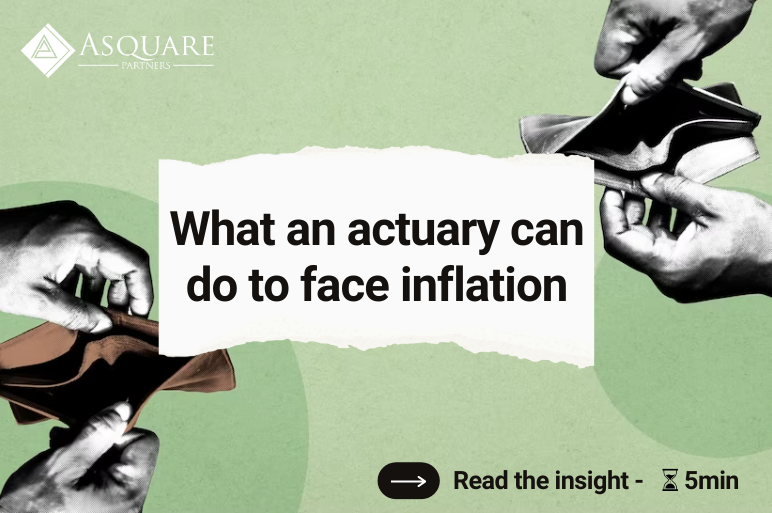Keeping Up With The Market – April 2023
Every month, we help you keep up with the Belgian and Luxembourg insurance markets.
Mergers and acquisitions
La Carac acquires Ageas France
While we announced in March that La Carac was in exclusive negotiations with Ageas for the acquisition of its French subsidiary, the final decision has been taken: it is indeed the mutual insurance La Carac that acquires Ageas France, which includes Ageas Retraite, Ageas Patrimoine and Sivaconline. Ageas’ life and pension activities amount to a profit of €6.1 million.
This acquisition will have an impact on Ageas’ Solvency II ratio with a 9% increase. The acquisition is expected to close in the third quarter of 2023.
Product
 Lalux launches a new product
Lalux launches a new product
EasyLIFE Invest for Future is the name of the investment product launched by the Luxembourg insurance company Lalux. Thanks to its different formulas, this product is adapted to each type of investor and his propensity for risk. Thus, investment funds and guaranteed capital are available.
Moreover, Lalux specifically states that its product meets ESG criteria.
Results
- Ethias’ annual results
- KBC and the impact of IFRS 17 on results
- The Luxembourg insurance sector in figures
- OneLife results
- Cardif Lux Vie results
Ethias’ annual results
For the year 2022, Ethias reported a stable net result compared to the previous period, amounting to €191 million.
On the one hand, the operating result fell in non-life (€169 million) and rose by 4% in life (€75 million). On the other hand, premium income increased by 5%. More precisely, non-life premium income reached € 1,512 million (+8%) and life premium income reached € 1,402 million (+2%).
The Solvency II ratio is 170% due to the economic situation.
KBC and the impact of IFRS 17 on results
IFRS 17, which came into effect for reporting at the beginning of this year, has had an impact on the income statements of the bancassurer KBC Group. Insurance income, financial insurance income and expenses, and insurance services expenses are all affected by IFRS 17. Specifically, total income is 11.15 billion euros (then estimated at 9.4 billion euros under IFRS 4) and operating expenses are estimated at 4.75 billion euros ( reported at 4.4 billion under IFRS 4).
The Luxembourg insurance sector in figures
Despite a bounce-back period in 2021, the year 2022 recorded an overall premium income of 40.2 billion, a decrease of 4.3%.
In particular, the 15.7% increase in non-life inflows could not balance out the 16.3% decline in life inflows.
Non-life premium income has been rising steadily since 2018, thanks in particular to international business. Indeed, it has increased by 12.1 billion in 5 years. Locally, non-life business is still growing by 7%, reaching 1.2 billion. Motor and property insurance are the main sources of this increase.
While most of the market’s life premium income comes from the EU, local life premium income decreased by 20% to 1.6 billion.
OneLife results
When publishing its results, the life insurer OneLife reported that 2022 was a very successful year. Indeed, the net result reached 16.9 million euros, an increase of 20%.
In addition, the insurer’s inflow of funds also increased, by 30%, to 1.4 billion euros. This increase is proof that the Luxembourg insurer is gaining a foothold in the Belgian and French markets.
According to OneLife’s CEO, Elio Fratini, “These results are the fruit of the H24 strategic plan deployed over the past two years to stimulate and diversify our European distribution by focusing on efficiency, support and innovation.
Cardif Lux Vie results
The Luxembourg insurer Cardif Lux Vie announced a lower net turnover, reaching €2.7 billion, compared to €3.4 billion in 2021. Its net profit after tax is €47.1 million, a decrease of 5.8%. The insurer also saw a decline in its assets under management to €29.3 billion.
Nationally, business amounted to 100.5 million euros, with a 34% increase in investment savings.
Market
- Overview of Belgian UCIs
- The NBB publishes a charter on sustainable and responsible investment
- Financial behaviour of households
- Car insurance will need to adapt
- Moody’s’ outlook for the Belgian market
- No split for EY
- AG Insurance is the most attractive employer
- Joint paper of the EBC and the EIOPA concerning climate-related claims
Overview of Belgian UCIs
The FSMA has published the key figures for Belgian Undertaking for Collective Investment (UCI) for the fourth quarter of 2022.
The first key figure is the increase in the number of so-called sustainable funds. Indeed, the latter represents 73% of the sector, compared to only 60% a year earlier.
Secondly, mixed funds underwritings amount to €2.3 billion, compared to €500 million for pension funds.
Finally, the total net assets of UCIs decreased by 13.2% to €184.4 billion (2021: €212 billion). This decrease is explained in particular by the fluctuation of the financial markets.
Overall, the volume of underwritings decreased in 2022, although it remains positive (€5.4 billion).
The NBB publishes a charter on sustainable and responsible investment
The NBB continues its path toward sustainability by publishing its charter on sustainable and responsible investment. This charter constitutes a framework for the management of the Bank’s own reserves.
Considered as the final objective of its strategic asset allocation policy, this charter aims to provide a framework for the management of portfolios that are not subject to monetary policy. To this end, it gathers internationally recommended information.
In addition, the bank will publish an annual report on the climatic impact of its assets. Finally, the bank will be transparent about the impact of climate risk on its portfolios.
Financial behaviour of households
The NBB has published key figures on the financial behaviour of households. Households saw their assets decrease by €78.2 billion, mainly due to the rise in interest rates. More specifically, the value of insurance products lost €55.4 billion, impacting the valuation of life insurance reserves.
With regard to the behaviour of households, they sold their products, resulting in a drop of €5.2 billion. On the other hand, investment funds and listed shares are still attractive to households, with 10.9 billion and 3.4 billion euros respectively invested.
Car insurance will need to adapt
According to Capgemini’s P&C insurance survey, the rise of shared and electric vehicles and multi-modal transport solutions means that insurers will have to adapt, taking into account these new practices in their insurance policies. In particular, the risk of hacking for connected cars and the higher repair costs of electric cars are crucial points of attention for the sector. However, the insurers surveyed believe that their technological capacity and expertise will not be sufficient to meet the mobility requirements in their policies.
Moody’s’ outlook for the Belgian market
Moody’s rating agency states that the outlook for the Belgian life insurance market is stable.
The decrease in guaranteed returns and the increase in interest rates should benefit insurers, who should have better investment margins this year. In addition, unit-linked policies will continue to be preferred.
According to the agency, this outlook would reduce inflation on insurers’ expenses.
No split for EY
The planned demerger of EY’s consulting and auditing activities will not take place after all. The main reason for this is the unwillingness of the group’s American entity to carry out the demerger plan, in particular, because of the tax consulting business, which overlaps with the consulting and auditing business.
Other reasons for the decision were that the consulting business had become less attractive financially in recent times and that the debt for this business had increased due to rising interest rates.
As a result, possible rotations of staff and local divisions may take place.
AG Insurance is the most attractive employer
According to a survey released by Randstad, AG Insurance would be the most attractive insurance when it comes to employment. AG Insurance is also part of the top 50 including all sectors. In addition, the “job security”, the “attractive salary and social benefits” and a “good work/life balance” within AG are ranked in the top 3 at sector level.
The joint paper of the EBC and the EIOPA concerning climate-related claims
Climate risk is in the spotlight of the EIOPA and the ECB. Indeed, the organisations recently published a joint discussion paper which describes the lack of cover for claims stemming from climatic events within the EU. In this paper, the EIOPA and the ECB give suggestions on how to better insure households and businesses against climate-related natural catastrophes such as floods or wildfires.
According to the EIOPA, only about one-quarter of all climate-related catastrophe losses in the European Union are insured. Petra Hielkema, Chairperson of the EIOPA stated that: “In order to efficiently protect our society, we need to address the concern of the increasing insurance protection gap by proposing and finding appropriate solutions.”
Legislation
Group insurance in the spotlight
The Minister for Pensions, Karine Lalieux, aims to tax the capital paid out under group insurance. More specifically, capital:
- over €679,500 will be taxed at 33%,
- between €478,130 and €679,500 at 25%,
- between €319,391 and €478,130 at 20%.
A bill to easily change insurers
A bill will soon be implemented to allow policyholders to change easily of insurers. Indeed, the Chamber’s economic commission has approved the socialist parties’ project, which aims to allow policyholders to change their insurance policy immediately after one year within the same insurer, free of charge.
This project is a reaction to the major competitive pressure in the European market, since the possibility of canceling one’s contract after one year is already in force in our neighbouring countries.
Measures are planned to facilitate this change. The new insurer will also take care of the cancellation procedures for the policyholder in the case of liability and car insurance.
Sources:
- L’Echo, Ageas vend ses activités françaises d’assurance vie à la mutuelle Carac
- Assuropolis, Ethias : résultats 2022
- Assuropolis, Évolution du secteur des fonds d’investissement belges en 2022
- Assuropolis, La Banque nationale de Belgique adopte des mesures essentielles pour une économie climatiquement neutre, durable et inclusive
- Paperjam, 2022 : année compliquée pour l’assurance
- Assuropolis, Le patrimoine financier des particuliers belges a chuté de 94,5 milliards d’euros en 2022
- Paperjam, Le chiffre d’affaires de Cardif Lux Vie en baisse de 21%
- Assuropolis, Bientôt, vous pourrez changer d’assureur gratuitement et à tout moment
- Assuropolis, Les changement d’assureur bientôt facilité
- Assuropolis, Karine Lalieux voudrait taxer jusqu’à 33% les gros capitaux d’assurance de groupe
- Assuropolis, KBC communique l’impact de la norme IFRS 17 sur le compte de résultats avec des résultats comparatifs, ratios clés et prévisions financières à court et à long terme retraités
- Assuropolis, L’évolution de la mobilité transforme le rôle de l’assureur automobile
- Atlas Magazine, Moddy’s : perspectives stables pour le marché belge de l’assurance vie
- Paperjam, Réaliser vos projets grâce à un investissement responsable
- L’Echo, EY vulnérable après l’échec de son opération de scission
- Assuropolis, AG reste l’employeur le plus attractif du secteur de l’assurance selon une étude de Randstad
- Assuropolis, Ageas signe un accord de vente de ses activités d’assurance Vie en France
- Paperjam, Un résultat en hausse de 20% pour OneLife
- Press release, EIOPA and ECB call for increased uptake of climate catastrophe insurance









